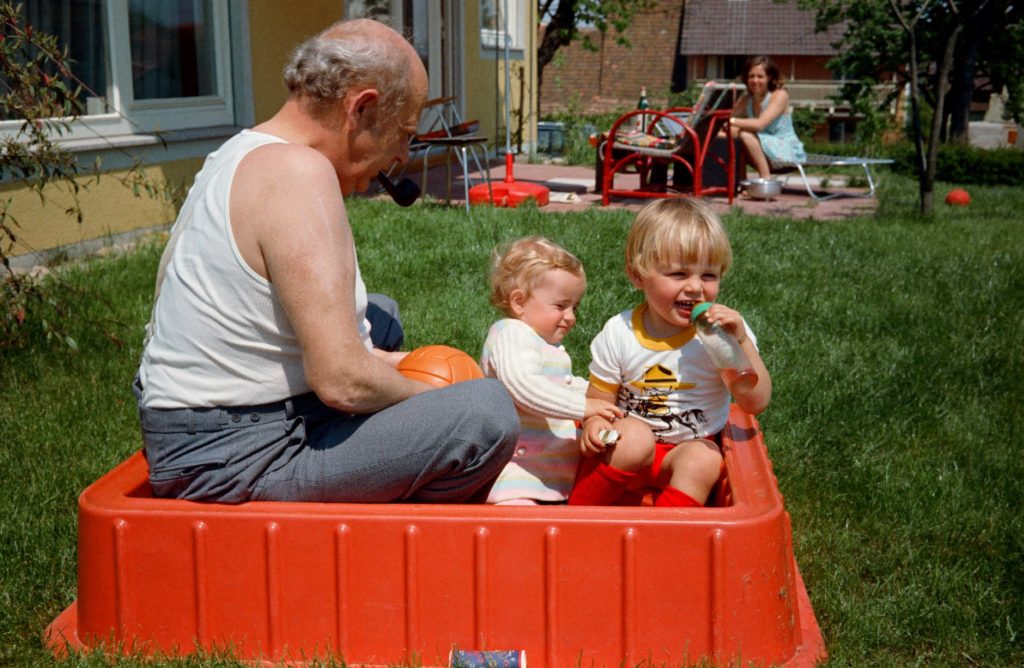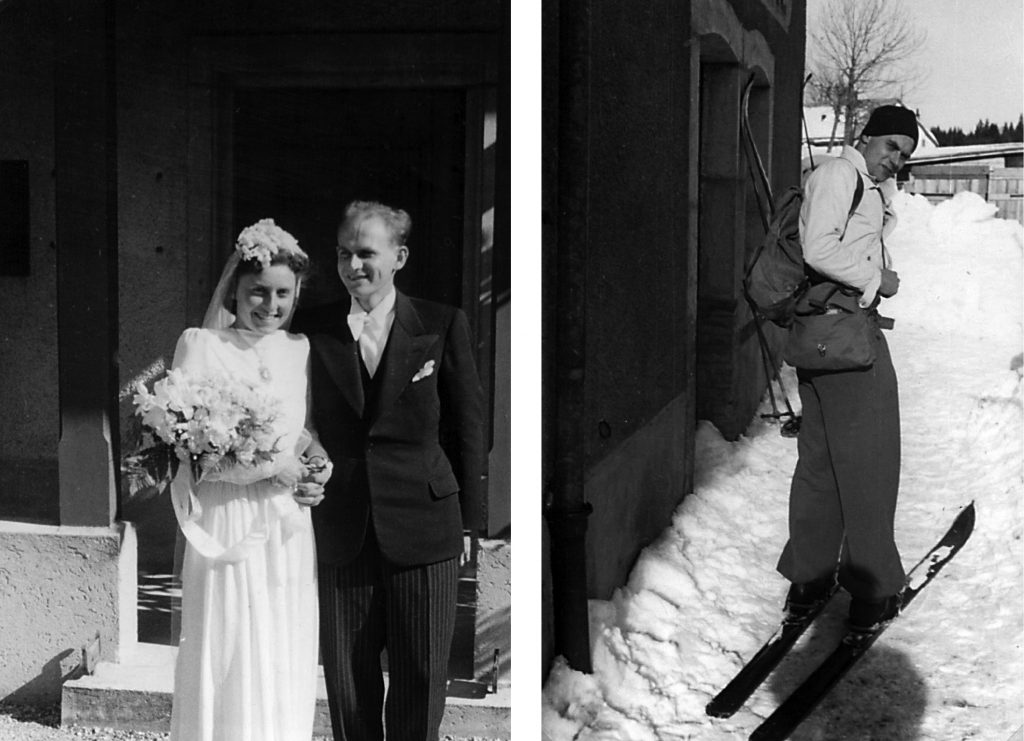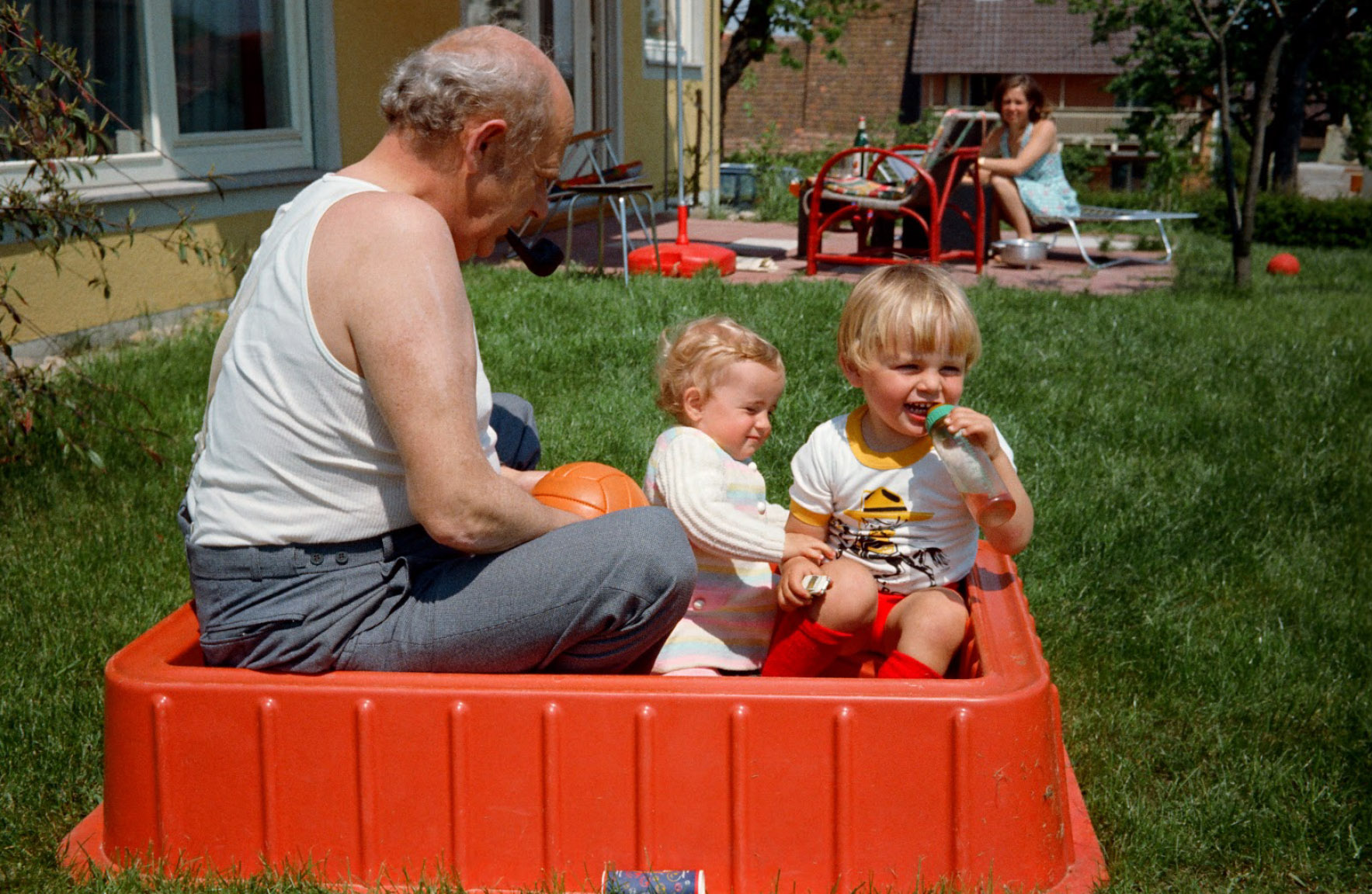How a Funeral Led to One of the Largest Scanning Services in the World

Grandfather Martin playing with his grandchildren in Switzerland. The little boy with the bottle is one of ScanCafe’s founders, Laurent Martin.
On our quest to save family photos, we run into kindred spirits. We meet like-minded people who are passionate about preserving photos and the stories they tell. They inspire us; they challenge us; they keep us going. And often, their stories surprise us! That’s why we were thrilled to connect with the founders of ScanCafe, who shared the story of how a funeral led to one of the largest scanning services in the world. In addition to being committed to digitizing family photos, they are also innovators. Needless to say, we were excited to interview them about the “why” behind ScanCafe. What catalyzed them to start a company that has become a leader in the preservation industry? Here’s their story…
Q. We are big fans of ScanCafe and the work you do to preserve family history. What inspired you to start ScanCafe?
A. Our story began with a funeral – the funeral of our co-founder’s grandfather in Switzerland. Grandfather Martin was a man of many talents, one of which happened to be photography. Tragically, Grandfather Martin’s photos were hidden away in boxes. Our co-founder, Laurent, knew he couldn’t let his grandfather’s photos stay hidden. Those images told the story of Laurent’s family. Getting the images out and digitizing them would give his children and generations to follow access to a priceless collection of memories. Laurent is an engineer by training, so he felt he could get the job done as long as he tackled it systematically and with his usual attention to detail.
But when he started working on the large photo collection, he realized what a tedious and frustrating exercise it was. There were so many images spread across such a variety of media that he knew he wouldn’t come out of the project with his sanity intact. So, that experience was the catalyst for launching a service to support people in their memory preservation projects; to provide quality scanning at great prices so that people could focus on enjoying and sharing their photos. After all, memories are vital pieces of family legacy.
Q. In an era when most folks use their phones to capture memories, why do you think analog photos still matter?
A. It is true that the future of photography is digital. But its past was not – this is where the disconnect lies. Most of us have multiple boxes of analog memories in the form of photos, slides and negatives. These are memories that we owe to future generations to preserve. We may think that they are safe as long as they are boxed and put away. But nothing could be further from the truth. Printed photos are vulnerable to age-related damage. Slides and tapes are easily misplaced or lost during a move. And an unforeseen event like a flood or fire could wipe out an entire collection before we’ve even had a chance to do anything about it. I’m not trying to play up doomsday scenarios, but just remind families that they should act sooner rather than later to preserve those memories.
We recently received a very moving letter from a customer who lost a lifetime collection of photographs to flooding caused by Hurricane Sandy in 2012. Almost everything was gone except for a box of 35mm slides in the attic and two cherished photos that happened to be in his office. He shipped the slides to us to scan and added the two photos to the order at the last minute. It’s humbling to think that he trusted us with the precious remnants of his collection.
Q. How can our families connect with ScanCafe and check out the services you offer?
A. The prospect of scanning a large analog collection spanning multiple formats can be pretty daunting. But we want to remind people that that’s the reason we’re here – to take the pain out of the process. Anybody who is looking at digitizing and archiving their family photos can find out more about how we do it on our website. If you were to peek into our physical scanning facility, you would see that we have a highly-secure and foolproof system in place. For starters, we weigh every single customer package down to the gram level – once when it is opened and again before it is sealed. If there is even a slight discrepancy between these two weights, we freeze the entire operation until we can trace the source of the variation. We treat our customers’ photos like gold and our facility is designed as a Fort Knox for them. We have surveillance cameras to videotape key parts of the operation. Our quality checks and stringent process control are what make us one of the largest and most trusted photo scanning companies in the country. We have made significant investments in precise and secure tracking systems so that we can protect our customer’s most valuable assets: memories.

Left: Wedding in 1944. Right: Grandfather Martin in the Swiss Alps, circa 1936.
Q. What do you think is the biggest barrier to families taking time to digitize their photos? And a logical follow up…why do so many photos sadly end up in thrift shops?
A. I think there are so many people out there who intend to do something about their family’s photo archives. It really is a unifying human motivation; we all want to preserve memories and share them with others. But life and its demands get in the way. And so we backburner our photo projects, thinking we’ll get to them at some point, when we have more time. But the longer we wait, the greater the risk of losing our memories forever. We insure our homes, cars and other possessions, but we don’t think about our photos in the same way. Ironically, most of us put a much higher sentimental value on our photos than on our material possessions. There is always something poignant about discovering old black-and-white snapshots in flea markets and thrift shops. You wonder who the people in the photos were and what their lives were like? And you wish you could ask them. You wish someone had taken the time to save them. Increasingly these days, you read about attempts to reunite families with their photo legacies using the digital networks now available. While that’s wonderful, we must all work harder to preserve our photos before it’s too late. After all, memories are priceless.
Q. Anything else you’d like to share with the Save Family Photos community?
A. I just want to remind families that they don’t have to feel overwhelmed by this mission. It’s possible and perfectly reasonable to seek help. Granting yourself that option can make the difference between starting and sticking with it, or putting it off yet again. There’s a real-time counter on the our website that logs how many images have been manually scanned at our facility. At the time of this interview, that number was up to 136,507,062. We’ve been doing this for a long time; you can trust us with your memories. They matter to us, as if they were our own.
*For those who are interested in trying us out, it’s easy to get started. And as part of our support of the Save Family Photos mission, we have a special promo. When you’re ready to get started saving your family photos, enter the code SFP25 to get 25 percent off your order!
 About the Author: Naren Dubey is a co-founder and CEO of Scancafe (a photo digitization and restoration service) and Photogurus (a digital photo story design service). He enjoys painting, photography and enabling people to organize and preserve their memories.
About the Author: Naren Dubey is a co-founder and CEO of Scancafe (a photo digitization and restoration service) and Photogurus (a digital photo story design service). He enjoys painting, photography and enabling people to organize and preserve their memories.
*Discount above applies to paper photos up to 8×10, 35mm color negatives, 35mm color slides, all video formats, SD and HD movie film. Not valid in combination with any other offer or service, or with USA Express, gift cards, gift boxes, and value kits.





No Comments